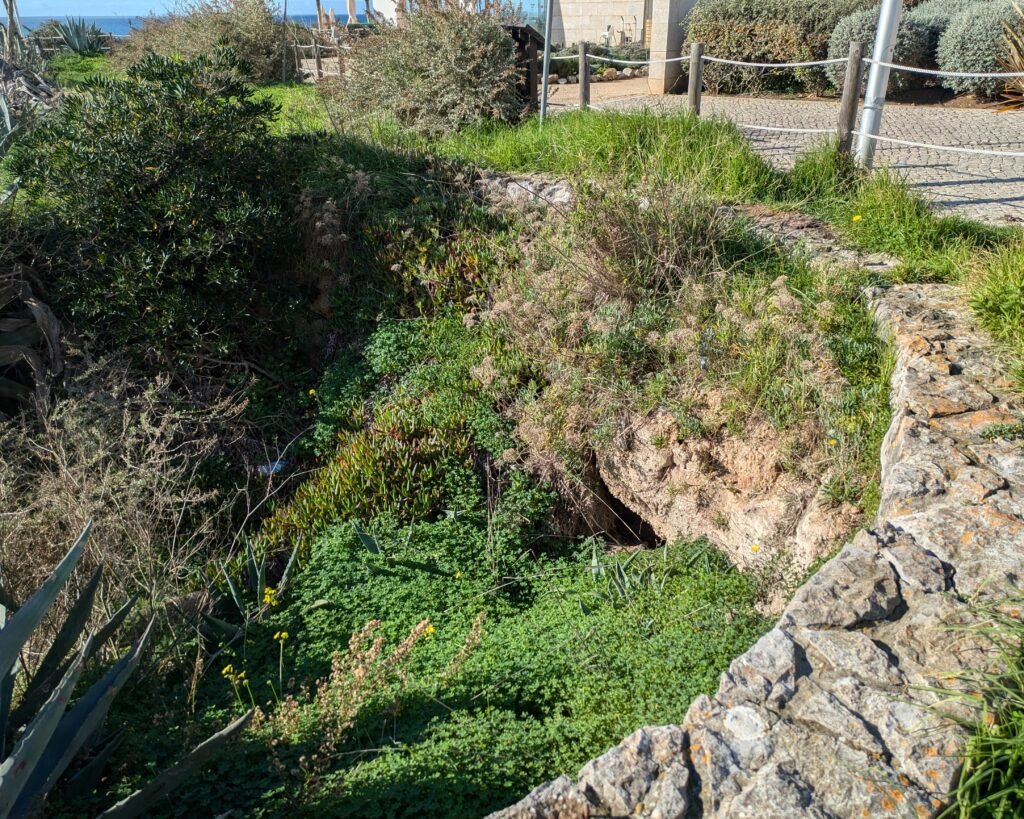Stand on the cliff face and look off to sea, enjoying the fresh breeze. The surf below competes with the noise of the traffic along the Avenida Marginal. Look down: there surrounded by a circular wall and covered by vegetation are the vestiges of caves that were carved into the rock over 4,000 years ago. Think about how time has eroded the waterfront here: rocks tumbling down from the cliff, taking portions of the human-made caves as well as human remains, artefacts, etc. Someday, even this rock wall memorial will disappear.




These human-made caves were first found and excavated in the 1940s by Leonel Ribeiro. They were dated back to the Late Neolithic or Chalcolithic period, approximately 2,500 BCE. Dozens of burials were found in Cave 1, along with a wide variety of artefacts including golden rings, clay pots, carved stone and bone items, and more. Cave 2 was less rich in artefacts, and may have been from the earliest stage of occupation.The caves were already in a bad state of preservation, with almost no evidence of the access corridor left after erosion of the cliff face.
Artefacts found in the caves are housed in the Town Museum of Cascais:


Since the excavations, further erosions have worn away what was left of the caves. There is a circular walled-off section of the cliff face, preserving the site as a “memorial” to the caves. Visiting the site doesn’t allow much of a sight of the original caves, but the location is beautiful and well worth a visit.
Location
The site is located in the Lisbon district, municipality of Cascais, in the town of São Pedro do Estoril. It is on a cliff face at the point known as Pedra do Sal, beside the beach of São Pedro do Estoril. The caves are essentially completely destroyed now.
Access
The memorial to the caves (a semi-circular walled-off section of the cliff) is located on the walkway beside the Pedra do Sal interpretative centre. There is parking there and a walkway along the cliff top.
Signage
There used to be a sign along the walkway. It is gone now. (There is a photo of the sign from 2017 posted by archaeologist António Carlos Silva on his blog site.) There is a signpost with a map indicating the caves along the waterfront.


Links
- Article (in Portuguese) from Wikipedia
- Description (in Portuguese) from Cascais Town Council
- Inventory (in Portuguese) from Cultura Cascais
- Post with historic articles and photos (in Portuguese) from his blog, Memórias das Pedras Talhas, by António Carlos Silva
- Description (in Portuguese) from Archaeologist’s Portal of Directorate-General of Cultural Heritage
Nearby
There are more (intact!) artificial caves nearby in Alapraia (about 3km away). Further down the beach are the dinosaur footprints on Parede beach. (More fossilized dinosaur footprints were found at São Pedro do Estoril, but I have not been able to identify them.) You can see artefacts from the São Pedro caves at the museum in Cascais, about 5km away.

Pingback:Roman Villa of Freiria - Prehistoric Portugal